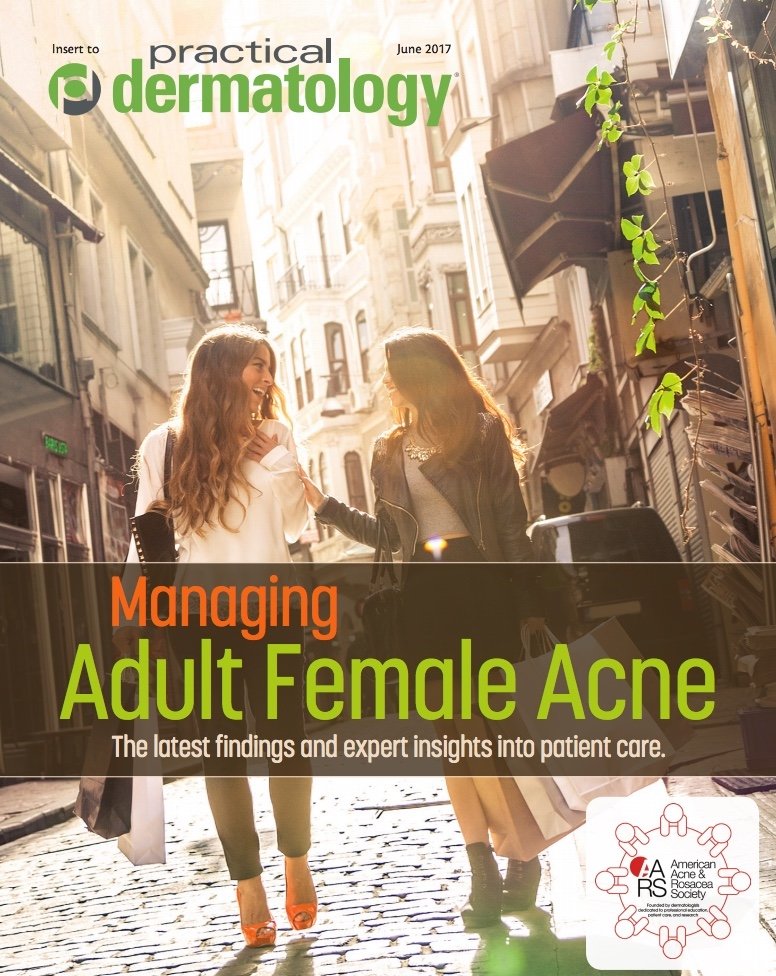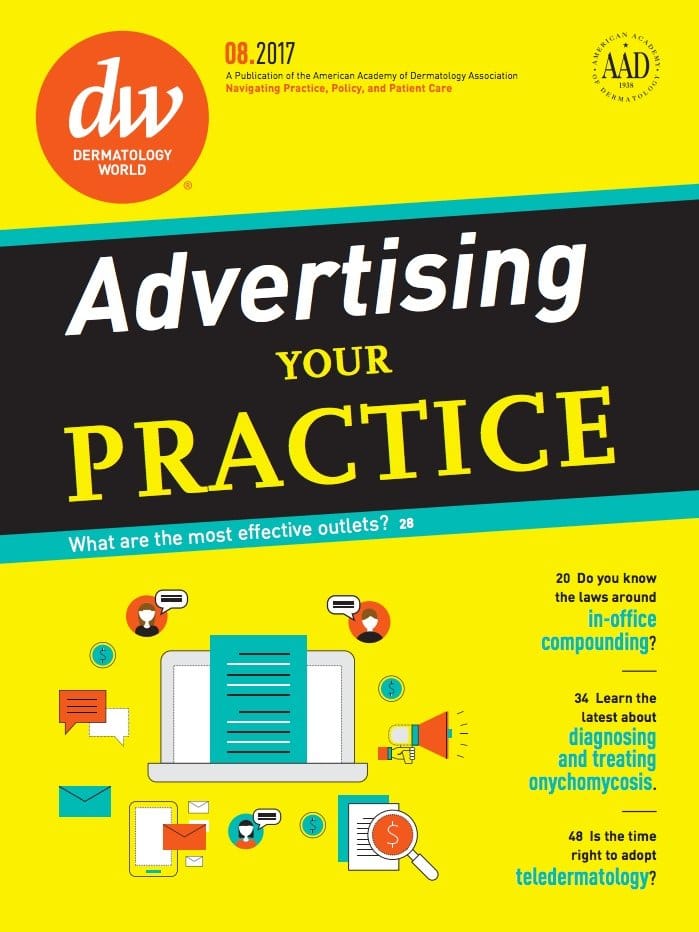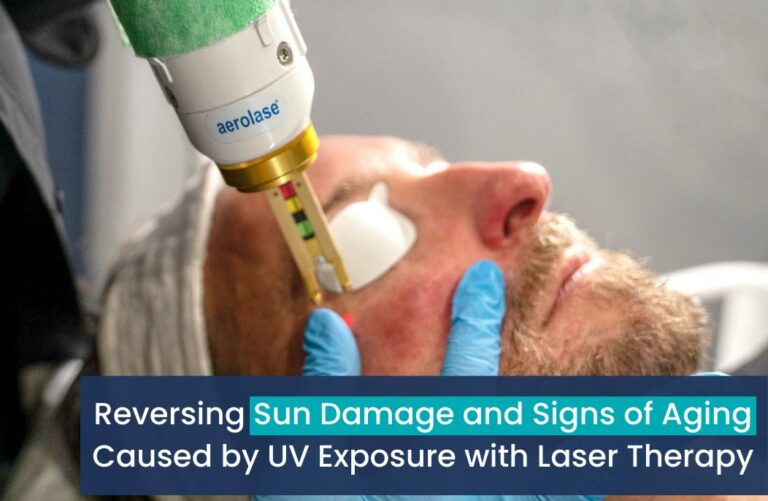Practical Dermatology July 2017
A unique clinical entity—at least among a subset of adult acne patients—may require special considerations for treatment. While lasers for acne continue to make a distinct mark on how dermatologists approach acne, there are also new innovations in OTC therapies, which offer excellent complement treatment.
Acne vulgaris (AV) is the most common skin condition treated in dermatologists’ offices. Although it predominantly affects adolescent-aged individuals, AV is a skin disorder that also affects male and female adults. Whether adult acne constitutes a unique clinical entity compared with cases of adolescent onset is a matter of debate; however, evidence is emerging that in some adult patients, the morphology and appearance of acne lesions is such that it requires special considerations for treatment.
ADULT FEMALE ACNE: PSYCHOSOCIAL IMPLICATIONS: Of the approximately 50 million new AV cases occurring each year,1 roughly 85 percent appear in individuals between the ages of 12 and 24.2 Yet, while acne prevalence declines with age, about 10 percent or more of women between 41 and 50 have acne.3 Furthermore, as many as one-third of adult acne sufferers report never having a breakout as a teenager4 —a fact that some interpret as evidence of a unique clinical entity, at least among a subset of adult patients.
In reality, however, whether or not adult acne is morphologically or clinically distinct remains a controversial topic. For instance, appearance of acne lesions may be masked by use of contraceptives; so-called late onset acne occurring in adulthood may simply coincide with discontinuation of birth control pills, among other factors. In addition, the prospect of look-alike entities underscores a need for education about the need for a professional consultation to avoid self-treating habits that may exacerbate the condition.
“There are actually a lot of adult female acne doppelgangers. There is a definite entity of adult female acne, but entities such as perioral dermatitis, rosacea, and milia that happen in adult women may result in acneiform-like lesions,” says Mona Gohara, MD, of Advanced DermaCare of Danbury, CT. “The problem these patients may face is that they may reach for an over-the-counter product, like a retinol-based formula, thinking it is helping, but it is doing the opposite. This is especially true in the context of people who are starting to use anti-aging products, some of which could inflame rosacea or perioral dermatitis.”
The propensity for patients to seek out OTC remedies is not all that surprising, especially given the detrimental psychosocial implications of AV. Acne breakouts in adults may induce levels of anxiety and stress similar to what is experienced by individuals with chronic disabling asthma, epilepsy, diabetes, back pain, or arthritis.5 Adult acne patients are also more likely to have a negative self image and the condition may be associated with depression and feelings of anger and embarrassment.6,7,8
Yet, according to Julie C. Harper, MD, of Dermatology and Skin Care Center of Birmingham, AL, it may not be necessary to be familiar with the voluminous data on the psychological consequences of acne to understand how it affects patients. Dr. Harper is also president of the American Acne and Rosacea Society (AARS).
“When I am lecturing, I often ask people, ‘How many pimples does it take to mess up your day?’ If we’re honest with ourselves, it’s not very many,” Dr. Harper says. “To me, the answer is really, ‘one.’ Those of us who don’t have acne every day take for granted that we don’t have acne every day.”
A MORPHOLOGICALLY DISTINCT ENTITY? While consensus is growing about the psychological consequences of acne breakouts in adults, there is still debate about whether it is a unique clinical entity. Previous classification schemes in the acne literature suggested that early-onset adolescent acne was more typically comedonal, appearing predominantly on the forehead, nose, and chin (ie, the “T-zone”), with papules and pustules appearing secondary to inflammation, whereas late-onset adult acne, appearing mostly on the lower chin, jawline, and neck (the “U-zone”), was thought to be more mild-to-moderate in severity but included more inflammatory lesions.9
A follow-up report published by the same lead author just two years later, however, reported data from an international, prospective, observational study indicating that most adult women surveyed displayed a spectrum of facial acne severity that was similar to adolescents.10 The study noted slight, but important, differences among those with mandibular presentations compared with presentation in the classic T-zone, as the former were less likely to have moderate or severe acne (7.1 vs 50.1 percent), truncal acne (19.0 vs 51.9 percent), postinflammatory hyperpigmentation (23.8 vs 51.9 percent), and erythema (19.0 vs 48.4 percent).
“There really is no consensus when it comes to female adult acne, in terms of its morphology and treatment,” says Dr. Gohara. “We think that it’s all hormonal, but it’s not really. It really runs the gamut of comedonal, inflammatory, and cystic.”
So, is adult female acne distinct? The prevailing thought seems to be that most cases of adult female acne are indistinguishable from those in adolescents; that they share a common pathogenesis. However, there also appears to be a subset of adult women who display a unique skin disorder characterized by a U-shaped pattern, “believed to be more common in late-onset [AV], often with persistence into the mid-40s.”11 Furthermore, older adult female patients fitting this subtype of AV presentation may display more inflammatory (and less comedonal) acne, with attendant implications for treatment.
“That’s a presentation that, while it certainly does not define every adult woman who has acne, it is very unique to adult female acne because we don’t see that morphology and that phenotype in younger women,” says Dr. Harper.
HORMONAL INFLUENCES: The occurrence of a unique skin presentation among some adult patients raises the prospect that the U-shaped pattern is pathognomonic of a particular etiology, perhaps triggered by increased hormone levels in adults versus adolescents. However, the evidence to support such a view is incomplete. While elevated androgen levels are often cited as a potential inciting mechanism, if there was a true correlation with acne breakouts, then males would likely be affected to a higher degree than is commonly described in the literature.
On the other hand, surveys also show that acne worsens around the time of the menstrual cycle in some adult women.12 According to Dr. Gohara, when these two bits of apparently disparate evidence are considered together, it suggests that absolute rise in hormones may be less significant than hormonal fluctuations. Another common denominator of adult versus adolescent life, she says, is the accumulation of greater amounts of stress, which fits with evidence showing that individuals displaying the U-shaped pattern of inflammatory and potentially refractory lesions along the jaw line are more likely employed (90.5 percent vs 78.6 percent), have greater daily stress levels (5.8 percent vs 5.1 percent), and psychologically stressful jobs (71.4 percent vs 57.5 percent).
“What’s the common denominator? In addition to life stress, things like childbirth and perimenopause cause hormonal fluctuations,” Dr. Gohara says. “It’s the same thing as when I see when young women start their periods, that’s why they get acne.”
Another way adult female acne could be understood as a unique entity is if treatment differences were apparent according to gender. In fact, some studies have shown this to be the case. In a large study investigating topical dapsone, which is known to have potent anti-inflammatory activity, women achieved greater reduction in acne lesion counts and higher success rates with 12 weeks of treatment.13 But, to date, there is not enough evidence to suggest that any particular treatment approach works better in adults versus adolescents.
While the full implications of suspected differences in outcomes according to gender remains unclear, it highlights that homogenous treatment strategies may be insufficient to achieve meaningful clinical results.
“I think it’s really about talking to your patients, getting a feel for how they want to go about treating their acne,” says Dr. Harper. “Some people want to take something by mouth, and some people don’t. Some people are going to be really good at remembering to do something twice a day, while others need once a day. I think instead of tailoring it to all women need this treatment and all men need that, treatment should be patient-specific, tailored to the individual.”
Nevertheless, she added, women inherently have different treatment options that are not available for men.
“Certainly there are different ways to treat acne when it comes to treating a hormonal component with things like spironolactone and oral contraceptive pills,” Dr. Harper says. “Any woman can benefit from those treatments that are considered hormonal treatments for acne. She doesn’t have to tell you that flares-ups seem to be worse around that certain time of the month because hormones are still going to have an impact on acne no matter what.”
There are currently four oral contraceptives with an indication to treat acne that also provide health benefits, such as prevention of pregnancy and reduced risk of endometrial, ovarian, and colorectal cancers. Spironolactone is also commonly used, although misunderstandings about the FDA boxed warning may contribute to unease with their use.
“There have been two large database studies that show that with spironolactone use over time, there seems to be no increased risk of breast cancer. I think people need to educate themselves about the safety of these products. Most of us are pretty aware of the efficacy. We just need to use them more,” Dr. Harper says.
At least among women who are interested in preventing pregnancy who also have acne, the role of oral contraceptives is pretty evident.
“If somebody needs contraception, then it’s a win every time because your risk of a birth control pill versus risk of a pregnancy, that’s an easy risk benefit analysis,” Dr. Harper says. “What is trickier is the woman who doesn’t need contraception. Can you still give her a birth control pill for acne? My answer is yes, you can. You do have to talk about risk there because now you’re comparing the risk of a birth control pill to the risk of acne, and that’s a little bit different risk benefit analysis there, but you can use them even in those situations.”
FACTORS FOR SUCCESSFUL TREATMENT: For many patients, OTC products are their first foray into treatment. By all accounts, OTC products can be effective and they have reasonable tolerability—although when they are used improperly, they can be both less than ideally effective and potentially irritating to the skin.
“A lot of people get OTC benzoyl peroxides, which are accessible. They put them on liberally, and that’s inevitably going to create a contact dermatitis. That can be irritating to anybody’s skin, let alone inflamed skin,” Dr. Gohara says.
While there are efficacious OTC products for standard acne, patients may still need to be educated on how often to use them and how much to apply. Dr. Gohara says she treats many patients in whom an OTC topical is sufficient, but there are also cases that warrant more potent agents.
“The different morphologies of acne are going to respond differently to treatment. Something that is more inflammatory may not respond that well to OTC products versus something that is just mildly comedonal,” Dr. Gohara says.
Most prescription topical therapies are effective for adult women, although they are less effective for deeper, more cystic acne. Even for those using systemic interventions, however, adjunctive topical therapy is common.
Because topical dapsone has been shown to have anti-inflammatory effects and superior efficacy in female patients compared to efficacy in the general study population, as described above, it may be considered for adult females.13 Adult women with acne who may be seeing emerging signs of skin aging may be interested in using a topical retinoid for the dual benefit of anti-aging and anti-acne effects.
Some topical acne therapies can be irritating to the skin, especially when therapy is first started; since adult women may have skin that is drier, photodamaged, or may have a compromised epidermal barrier due to aging, these effects may be compounded. This makes consideration of the vehicle formulation part of treatment selection.
A point of education involves the primary skin routine. Adult patients may be more likely than adolescents to have established skincare habits borne through years of experimentation—which may or may not be healthy with regard to acne development and/or treatment. For example, use of certain foundations and cover-ups may yield acne cosmetic. Products used along the hairline may also fuel inflammation that leads to acne lesion formation.
On the one hand, comedonal cosmetics can contribute to the etiology, while directing efforts to maintaining epidermal barrier function may help reduce flares and minimize the harsh effects of topical therapy.14,15,16
“Ideally, patients use a cleanser that is biologically neutral to skin pH to cleanse skin prior to putting on any potentially irritating acne products so that the barrier is healthy and so the skin can tolerate additional treatments. Same thing with moisturizers. Often times, when the skin is inflamed from acne, there are cracks in the skin. There’s a lot of hydration being lost and evaporated out. In order to keep that barrier healthy, it’s really important to have the right moisturizer as part of the routine,” says Dr. Gohara.
DISPELLING ACNE MYTHS: Educating about skin health in the context of acne treatment may contribute to the effectiveness of treatment but it may have benefits beyond the obvious. Despite its prevalence, many patients still believe that dirt causes acne, in turn causing them to use harsh toners and astringents that serve to inflame the skin. Getting patients to become aware of the negative consequences of such behavior—despite it being well intentioned—may be beneficial.
But acne myths may also stop certain patients from participating in skin habits that can be beneficial. According to Dr. Gohara, many of her acne patients avoid moisturizers under the presumption that they clog pores or else somehow contribute to acne pathogenesis. Yet not all moisturizers are created equal, she says, and their use is not something that be compromised in deference to treating acne.
Many acne patients avoid regular use of sunscreen, again under the notion that it may clog pores and lead to breakouts. “People with acne are very averse to wearing sunscreen, because they are afraid that that is going to inflame their skin and make it worse. But sunscreen is really important for avoiding post-inflammatory hyperpigmentation. I always educate on sun protection, sunscreen, and post-inflammatory hyperpigmentation, particularly in patients with darker color skin and when the skin has been manipulated,” Dr. Gohara says.




